Critically Analyzing and Evaluating HRM Literature, Theories, Models, and Practices
VerifiedAdded on 2022/12/26
|12
|3882
|5
AI Summary
This report critically analyzes and evaluates HRM literature, theories, models, and practices. It discusses the relationship between HR strategy and business strategy, models of SHRM, specific HR practices of performance management and reward systems, and more. The report contextualizes the discussion with British Petroleum (BP) as an example.
Contribute Materials
Your contribution can guide someone’s learning journey. Share your
documents today.
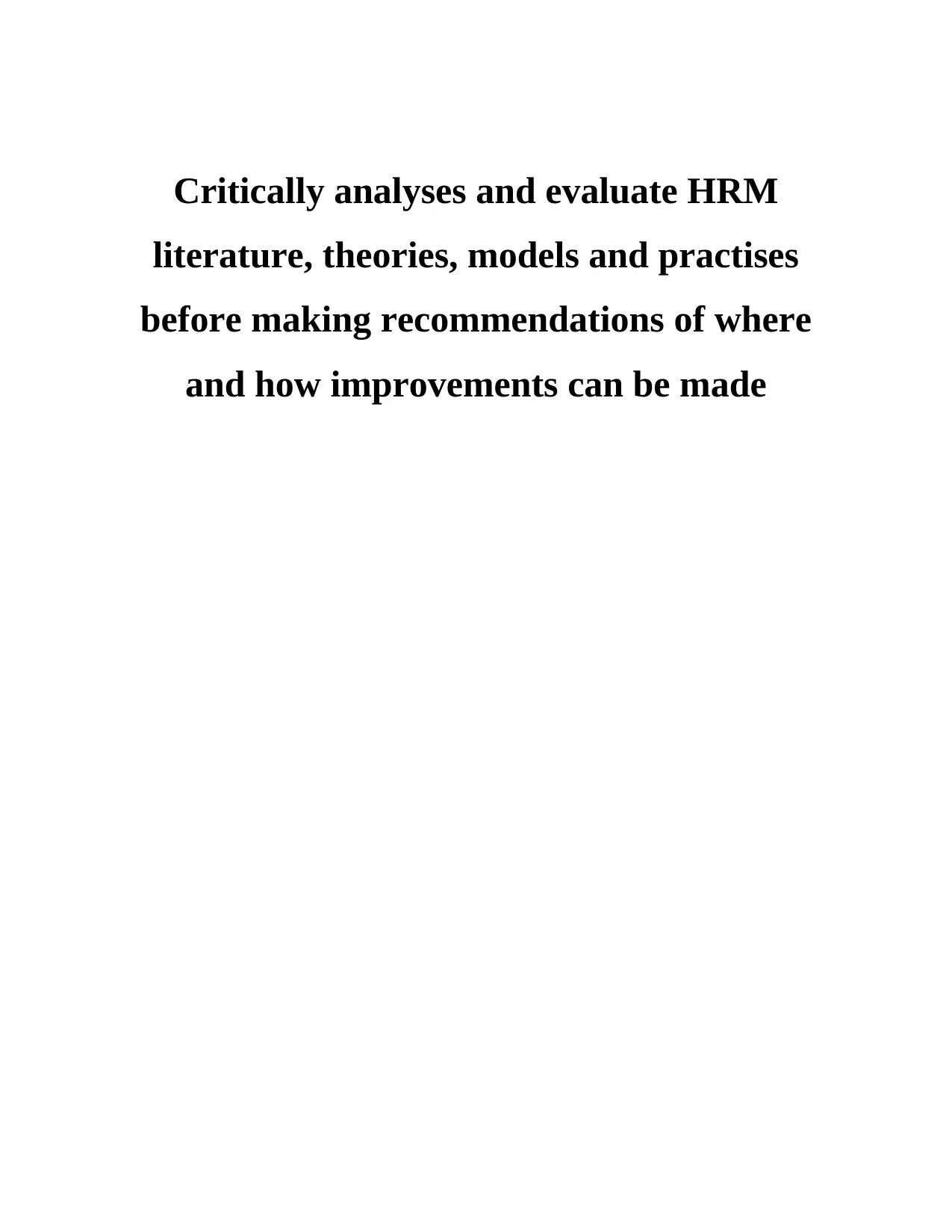
Critically analyses and evaluate HRM
literature, theories, models and practises
before making recommendations of where
and how improvements can be made
literature, theories, models and practises
before making recommendations of where
and how improvements can be made
Secure Best Marks with AI Grader
Need help grading? Try our AI Grader for instant feedback on your assignments.
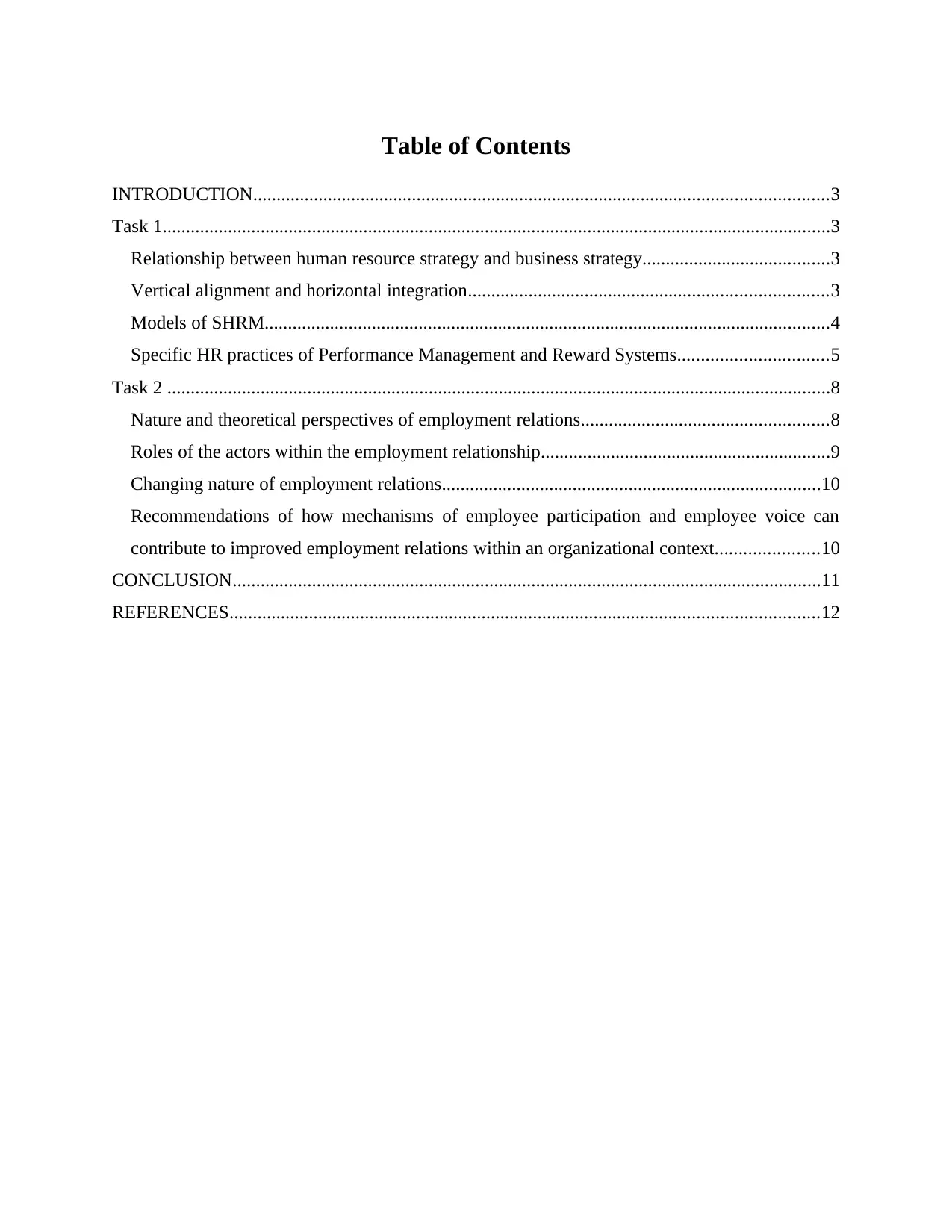
Table of Contents
INTRODUCTION...........................................................................................................................3
Task 1...............................................................................................................................................3
Relationship between human resource strategy and business strategy........................................3
Vertical alignment and horizontal integration.............................................................................3
Models of SHRM.........................................................................................................................4
Specific HR practices of Performance Management and Reward Systems................................5
Task 2 ..............................................................................................................................................8
Nature and theoretical perspectives of employment relations.....................................................8
Roles of the actors within the employment relationship..............................................................9
Changing nature of employment relations.................................................................................10
Recommendations of how mechanisms of employee participation and employee voice can
contribute to improved employment relations within an organizational context......................10
CONCLUSION..............................................................................................................................11
REFERENCES..............................................................................................................................12
INTRODUCTION...........................................................................................................................3
Task 1...............................................................................................................................................3
Relationship between human resource strategy and business strategy........................................3
Vertical alignment and horizontal integration.............................................................................3
Models of SHRM.........................................................................................................................4
Specific HR practices of Performance Management and Reward Systems................................5
Task 2 ..............................................................................................................................................8
Nature and theoretical perspectives of employment relations.....................................................8
Roles of the actors within the employment relationship..............................................................9
Changing nature of employment relations.................................................................................10
Recommendations of how mechanisms of employee participation and employee voice can
contribute to improved employment relations within an organizational context......................10
CONCLUSION..............................................................................................................................11
REFERENCES..............................................................................................................................12
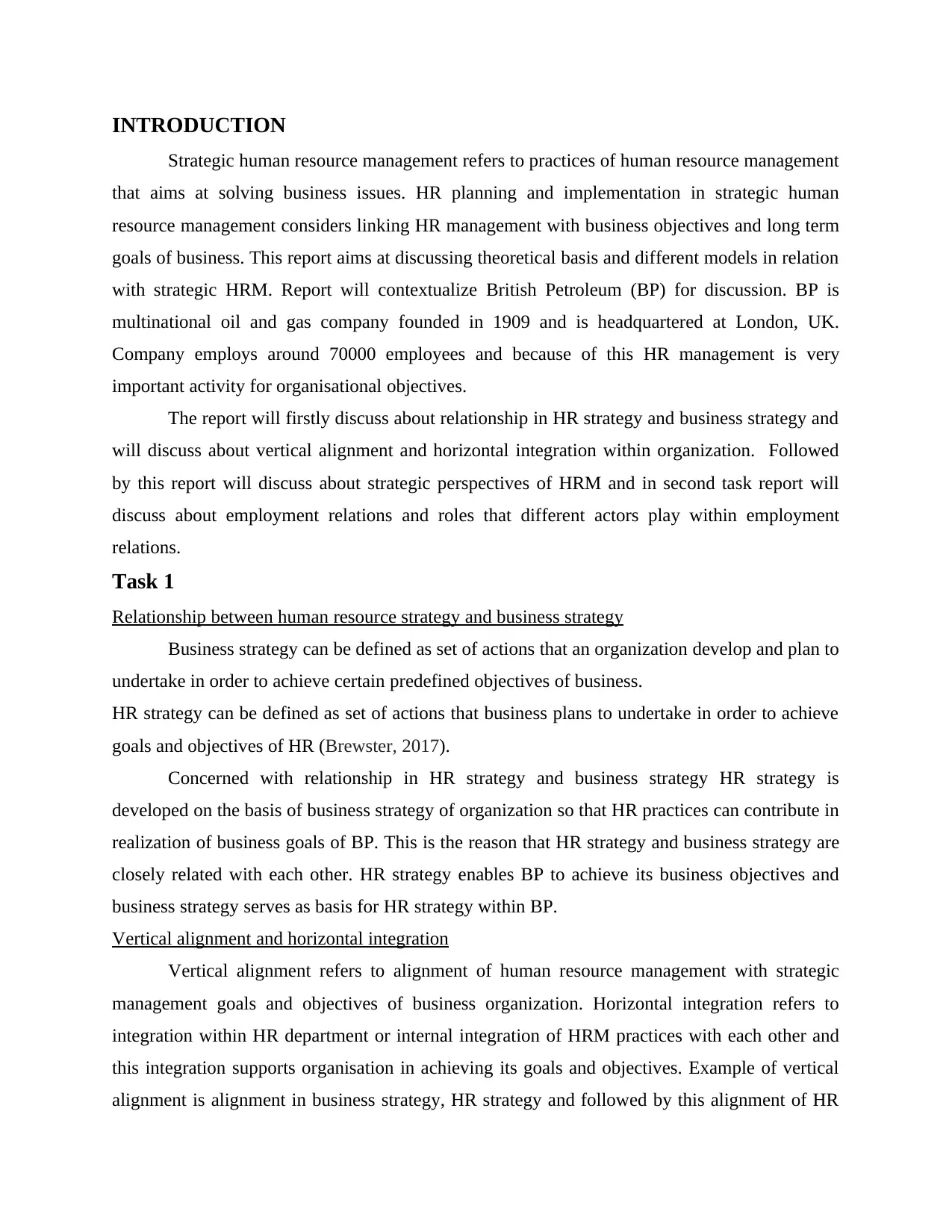
INTRODUCTION
Strategic human resource management refers to practices of human resource management
that aims at solving business issues. HR planning and implementation in strategic human
resource management considers linking HR management with business objectives and long term
goals of business. This report aims at discussing theoretical basis and different models in relation
with strategic HRM. Report will contextualize British Petroleum (BP) for discussion. BP is
multinational oil and gas company founded in 1909 and is headquartered at London, UK.
Company employs around 70000 employees and because of this HR management is very
important activity for organisational objectives.
The report will firstly discuss about relationship in HR strategy and business strategy and
will discuss about vertical alignment and horizontal integration within organization. Followed
by this report will discuss about strategic perspectives of HRM and in second task report will
discuss about employment relations and roles that different actors play within employment
relations.
Task 1
Relationship between human resource strategy and business strategy
Business strategy can be defined as set of actions that an organization develop and plan to
undertake in order to achieve certain predefined objectives of business.
HR strategy can be defined as set of actions that business plans to undertake in order to achieve
goals and objectives of HR (Brewster, 2017).
Concerned with relationship in HR strategy and business strategy HR strategy is
developed on the basis of business strategy of organization so that HR practices can contribute in
realization of business goals of BP. This is the reason that HR strategy and business strategy are
closely related with each other. HR strategy enables BP to achieve its business objectives and
business strategy serves as basis for HR strategy within BP.
Vertical alignment and horizontal integration
Vertical alignment refers to alignment of human resource management with strategic
management goals and objectives of business organization. Horizontal integration refers to
integration within HR department or internal integration of HRM practices with each other and
this integration supports organisation in achieving its goals and objectives. Example of vertical
alignment is alignment in business strategy, HR strategy and followed by this alignment of HR
Strategic human resource management refers to practices of human resource management
that aims at solving business issues. HR planning and implementation in strategic human
resource management considers linking HR management with business objectives and long term
goals of business. This report aims at discussing theoretical basis and different models in relation
with strategic HRM. Report will contextualize British Petroleum (BP) for discussion. BP is
multinational oil and gas company founded in 1909 and is headquartered at London, UK.
Company employs around 70000 employees and because of this HR management is very
important activity for organisational objectives.
The report will firstly discuss about relationship in HR strategy and business strategy and
will discuss about vertical alignment and horizontal integration within organization. Followed
by this report will discuss about strategic perspectives of HRM and in second task report will
discuss about employment relations and roles that different actors play within employment
relations.
Task 1
Relationship between human resource strategy and business strategy
Business strategy can be defined as set of actions that an organization develop and plan to
undertake in order to achieve certain predefined objectives of business.
HR strategy can be defined as set of actions that business plans to undertake in order to achieve
goals and objectives of HR (Brewster, 2017).
Concerned with relationship in HR strategy and business strategy HR strategy is
developed on the basis of business strategy of organization so that HR practices can contribute in
realization of business goals of BP. This is the reason that HR strategy and business strategy are
closely related with each other. HR strategy enables BP to achieve its business objectives and
business strategy serves as basis for HR strategy within BP.
Vertical alignment and horizontal integration
Vertical alignment refers to alignment of human resource management with strategic
management goals and objectives of business organization. Horizontal integration refers to
integration within HR department or internal integration of HRM practices with each other and
this integration supports organisation in achieving its goals and objectives. Example of vertical
alignment is alignment in business strategy, HR strategy and followed by this alignment of HR
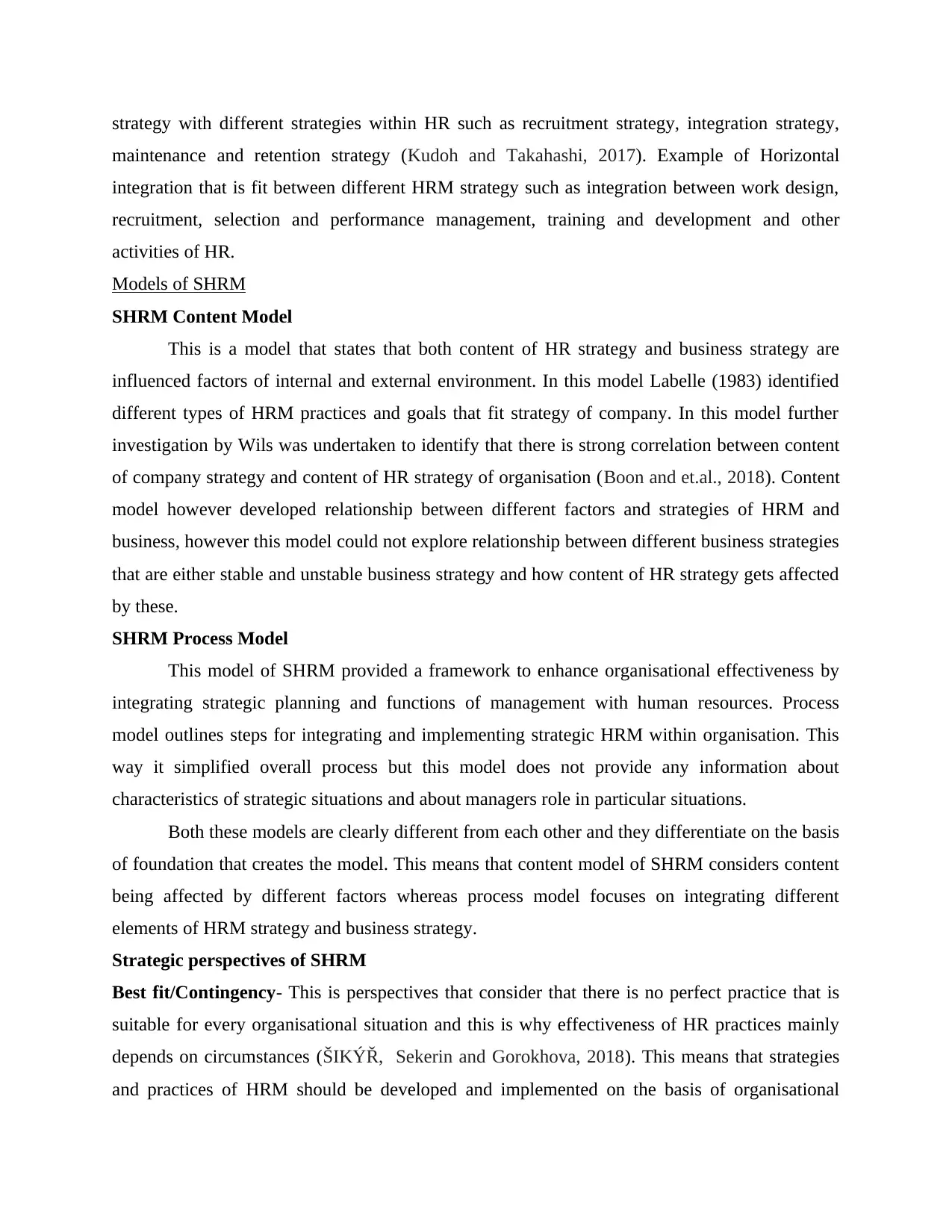
strategy with different strategies within HR such as recruitment strategy, integration strategy,
maintenance and retention strategy (Kudoh and Takahashi, 2017). Example of Horizontal
integration that is fit between different HRM strategy such as integration between work design,
recruitment, selection and performance management, training and development and other
activities of HR.
Models of SHRM
SHRM Content Model
This is a model that states that both content of HR strategy and business strategy are
influenced factors of internal and external environment. In this model Labelle (1983) identified
different types of HRM practices and goals that fit strategy of company. In this model further
investigation by Wils was undertaken to identify that there is strong correlation between content
of company strategy and content of HR strategy of organisation (Boon and et.al., 2018). Content
model however developed relationship between different factors and strategies of HRM and
business, however this model could not explore relationship between different business strategies
that are either stable and unstable business strategy and how content of HR strategy gets affected
by these.
SHRM Process Model
This model of SHRM provided a framework to enhance organisational effectiveness by
integrating strategic planning and functions of management with human resources. Process
model outlines steps for integrating and implementing strategic HRM within organisation. This
way it simplified overall process but this model does not provide any information about
characteristics of strategic situations and about managers role in particular situations.
Both these models are clearly different from each other and they differentiate on the basis
of foundation that creates the model. This means that content model of SHRM considers content
being affected by different factors whereas process model focuses on integrating different
elements of HRM strategy and business strategy.
Strategic perspectives of SHRM
Best fit/Contingency- This is perspectives that consider that there is no perfect practice that is
suitable for every organisational situation and this is why effectiveness of HR practices mainly
depends on circumstances (ŠIKÝŘ, Sekerin and Gorokhova, 2018). This means that strategies
and practices of HRM should be developed and implemented on the basis of organisational
maintenance and retention strategy (Kudoh and Takahashi, 2017). Example of Horizontal
integration that is fit between different HRM strategy such as integration between work design,
recruitment, selection and performance management, training and development and other
activities of HR.
Models of SHRM
SHRM Content Model
This is a model that states that both content of HR strategy and business strategy are
influenced factors of internal and external environment. In this model Labelle (1983) identified
different types of HRM practices and goals that fit strategy of company. In this model further
investigation by Wils was undertaken to identify that there is strong correlation between content
of company strategy and content of HR strategy of organisation (Boon and et.al., 2018). Content
model however developed relationship between different factors and strategies of HRM and
business, however this model could not explore relationship between different business strategies
that are either stable and unstable business strategy and how content of HR strategy gets affected
by these.
SHRM Process Model
This model of SHRM provided a framework to enhance organisational effectiveness by
integrating strategic planning and functions of management with human resources. Process
model outlines steps for integrating and implementing strategic HRM within organisation. This
way it simplified overall process but this model does not provide any information about
characteristics of strategic situations and about managers role in particular situations.
Both these models are clearly different from each other and they differentiate on the basis
of foundation that creates the model. This means that content model of SHRM considers content
being affected by different factors whereas process model focuses on integrating different
elements of HRM strategy and business strategy.
Strategic perspectives of SHRM
Best fit/Contingency- This is perspectives that consider that there is no perfect practice that is
suitable for every organisational situation and this is why effectiveness of HR practices mainly
depends on circumstances (ŠIKÝŘ, Sekerin and Gorokhova, 2018). This means that strategies
and practices of HRM should be developed and implemented on the basis of organisational
Secure Best Marks with AI Grader
Need help grading? Try our AI Grader for instant feedback on your assignments.
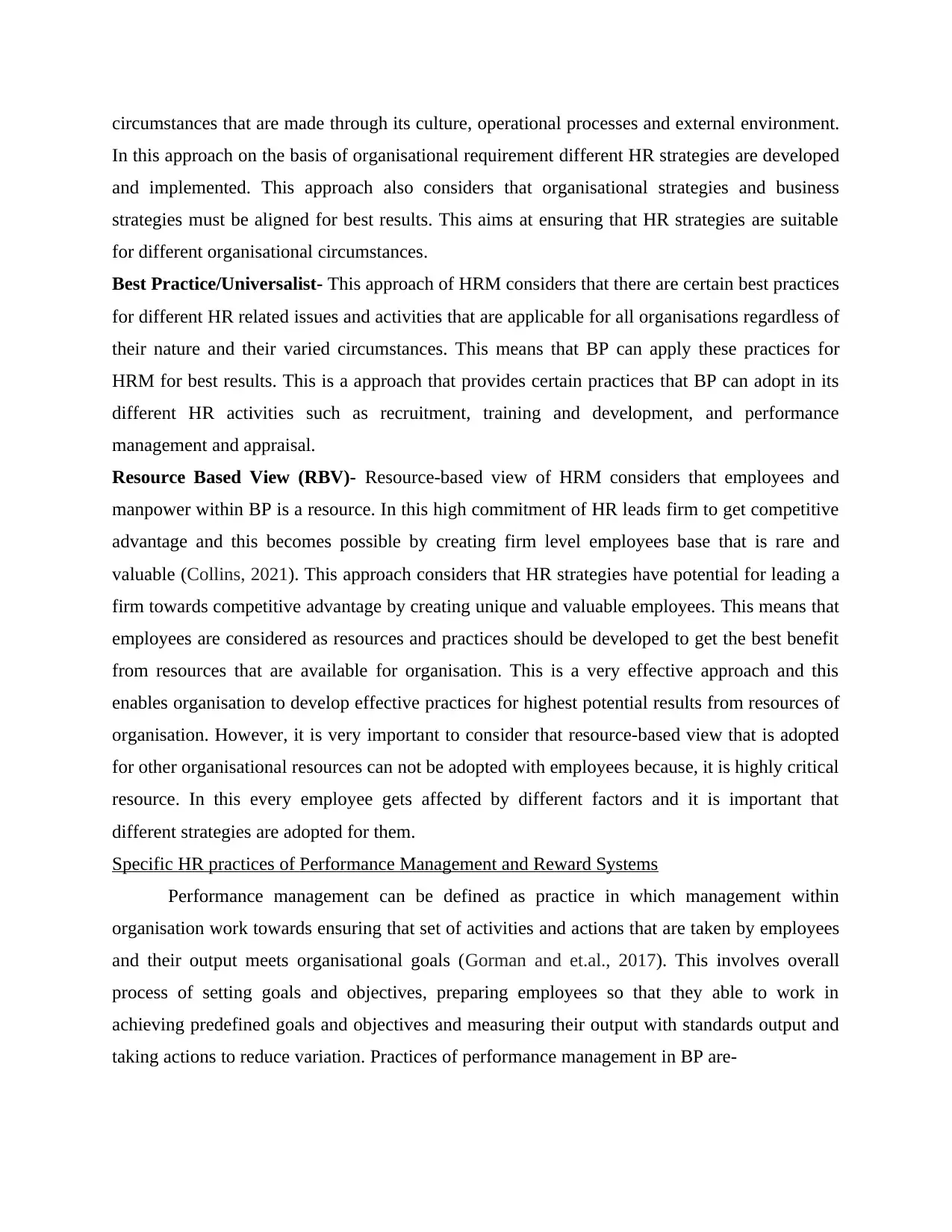
circumstances that are made through its culture, operational processes and external environment.
In this approach on the basis of organisational requirement different HR strategies are developed
and implemented. This approach also considers that organisational strategies and business
strategies must be aligned for best results. This aims at ensuring that HR strategies are suitable
for different organisational circumstances.
Best Practice/Universalist- This approach of HRM considers that there are certain best practices
for different HR related issues and activities that are applicable for all organisations regardless of
their nature and their varied circumstances. This means that BP can apply these practices for
HRM for best results. This is a approach that provides certain practices that BP can adopt in its
different HR activities such as recruitment, training and development, and performance
management and appraisal.
Resource Based View (RBV)- Resource-based view of HRM considers that employees and
manpower within BP is a resource. In this high commitment of HR leads firm to get competitive
advantage and this becomes possible by creating firm level employees base that is rare and
valuable (Collins, 2021). This approach considers that HR strategies have potential for leading a
firm towards competitive advantage by creating unique and valuable employees. This means that
employees are considered as resources and practices should be developed to get the best benefit
from resources that are available for organisation. This is a very effective approach and this
enables organisation to develop effective practices for highest potential results from resources of
organisation. However, it is very important to consider that resource-based view that is adopted
for other organisational resources can not be adopted with employees because, it is highly critical
resource. In this every employee gets affected by different factors and it is important that
different strategies are adopted for them.
Specific HR practices of Performance Management and Reward Systems
Performance management can be defined as practice in which management within
organisation work towards ensuring that set of activities and actions that are taken by employees
and their output meets organisational goals (Gorman and et.al., 2017). This involves overall
process of setting goals and objectives, preparing employees so that they able to work in
achieving predefined goals and objectives and measuring their output with standards output and
taking actions to reduce variation. Practices of performance management in BP are-
In this approach on the basis of organisational requirement different HR strategies are developed
and implemented. This approach also considers that organisational strategies and business
strategies must be aligned for best results. This aims at ensuring that HR strategies are suitable
for different organisational circumstances.
Best Practice/Universalist- This approach of HRM considers that there are certain best practices
for different HR related issues and activities that are applicable for all organisations regardless of
their nature and their varied circumstances. This means that BP can apply these practices for
HRM for best results. This is a approach that provides certain practices that BP can adopt in its
different HR activities such as recruitment, training and development, and performance
management and appraisal.
Resource Based View (RBV)- Resource-based view of HRM considers that employees and
manpower within BP is a resource. In this high commitment of HR leads firm to get competitive
advantage and this becomes possible by creating firm level employees base that is rare and
valuable (Collins, 2021). This approach considers that HR strategies have potential for leading a
firm towards competitive advantage by creating unique and valuable employees. This means that
employees are considered as resources and practices should be developed to get the best benefit
from resources that are available for organisation. This is a very effective approach and this
enables organisation to develop effective practices for highest potential results from resources of
organisation. However, it is very important to consider that resource-based view that is adopted
for other organisational resources can not be adopted with employees because, it is highly critical
resource. In this every employee gets affected by different factors and it is important that
different strategies are adopted for them.
Specific HR practices of Performance Management and Reward Systems
Performance management can be defined as practice in which management within
organisation work towards ensuring that set of activities and actions that are taken by employees
and their output meets organisational goals (Gorman and et.al., 2017). This involves overall
process of setting goals and objectives, preparing employees so that they able to work in
achieving predefined goals and objectives and measuring their output with standards output and
taking actions to reduce variation. Practices of performance management in BP are-
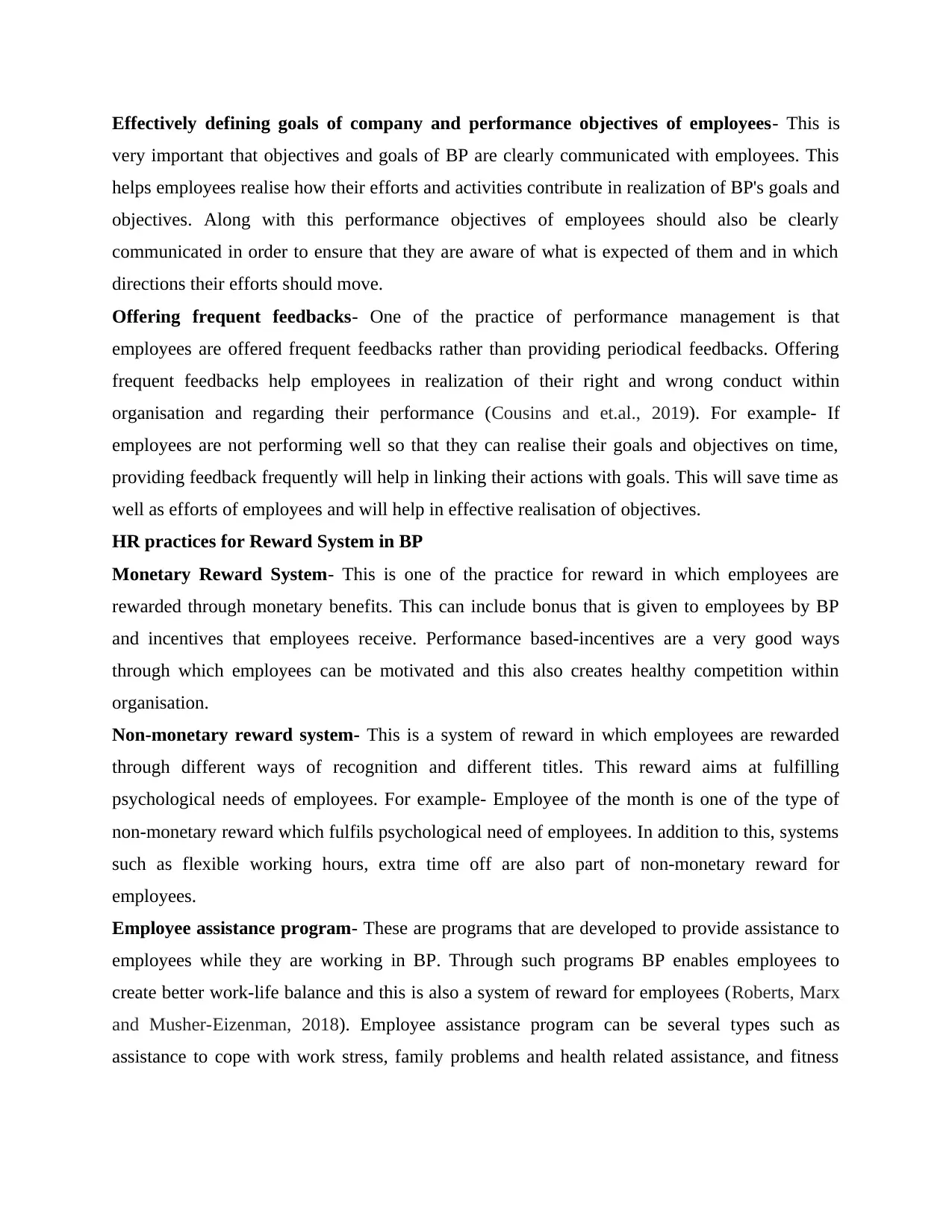
Effectively defining goals of company and performance objectives of employees- This is
very important that objectives and goals of BP are clearly communicated with employees. This
helps employees realise how their efforts and activities contribute in realization of BP's goals and
objectives. Along with this performance objectives of employees should also be clearly
communicated in order to ensure that they are aware of what is expected of them and in which
directions their efforts should move.
Offering frequent feedbacks- One of the practice of performance management is that
employees are offered frequent feedbacks rather than providing periodical feedbacks. Offering
frequent feedbacks help employees in realization of their right and wrong conduct within
organisation and regarding their performance (Cousins and et.al., 2019). For example- If
employees are not performing well so that they can realise their goals and objectives on time,
providing feedback frequently will help in linking their actions with goals. This will save time as
well as efforts of employees and will help in effective realisation of objectives.
HR practices for Reward System in BP
Monetary Reward System- This is one of the practice for reward in which employees are
rewarded through monetary benefits. This can include bonus that is given to employees by BP
and incentives that employees receive. Performance based-incentives are a very good ways
through which employees can be motivated and this also creates healthy competition within
organisation.
Non-monetary reward system- This is a system of reward in which employees are rewarded
through different ways of recognition and different titles. This reward aims at fulfilling
psychological needs of employees. For example- Employee of the month is one of the type of
non-monetary reward which fulfils psychological need of employees. In addition to this, systems
such as flexible working hours, extra time off are also part of non-monetary reward for
employees.
Employee assistance program- These are programs that are developed to provide assistance to
employees while they are working in BP. Through such programs BP enables employees to
create better work-life balance and this is also a system of reward for employees (Roberts, Marx
and Musher-Eizenman, 2018). Employee assistance program can be several types such as
assistance to cope with work stress, family problems and health related assistance, and fitness
very important that objectives and goals of BP are clearly communicated with employees. This
helps employees realise how their efforts and activities contribute in realization of BP's goals and
objectives. Along with this performance objectives of employees should also be clearly
communicated in order to ensure that they are aware of what is expected of them and in which
directions their efforts should move.
Offering frequent feedbacks- One of the practice of performance management is that
employees are offered frequent feedbacks rather than providing periodical feedbacks. Offering
frequent feedbacks help employees in realization of their right and wrong conduct within
organisation and regarding their performance (Cousins and et.al., 2019). For example- If
employees are not performing well so that they can realise their goals and objectives on time,
providing feedback frequently will help in linking their actions with goals. This will save time as
well as efforts of employees and will help in effective realisation of objectives.
HR practices for Reward System in BP
Monetary Reward System- This is one of the practice for reward in which employees are
rewarded through monetary benefits. This can include bonus that is given to employees by BP
and incentives that employees receive. Performance based-incentives are a very good ways
through which employees can be motivated and this also creates healthy competition within
organisation.
Non-monetary reward system- This is a system of reward in which employees are rewarded
through different ways of recognition and different titles. This reward aims at fulfilling
psychological needs of employees. For example- Employee of the month is one of the type of
non-monetary reward which fulfils psychological need of employees. In addition to this, systems
such as flexible working hours, extra time off are also part of non-monetary reward for
employees.
Employee assistance program- These are programs that are developed to provide assistance to
employees while they are working in BP. Through such programs BP enables employees to
create better work-life balance and this is also a system of reward for employees (Roberts, Marx
and Musher-Eizenman, 2018). Employee assistance program can be several types such as
assistance to cope with work stress, family problems and health related assistance, and fitness
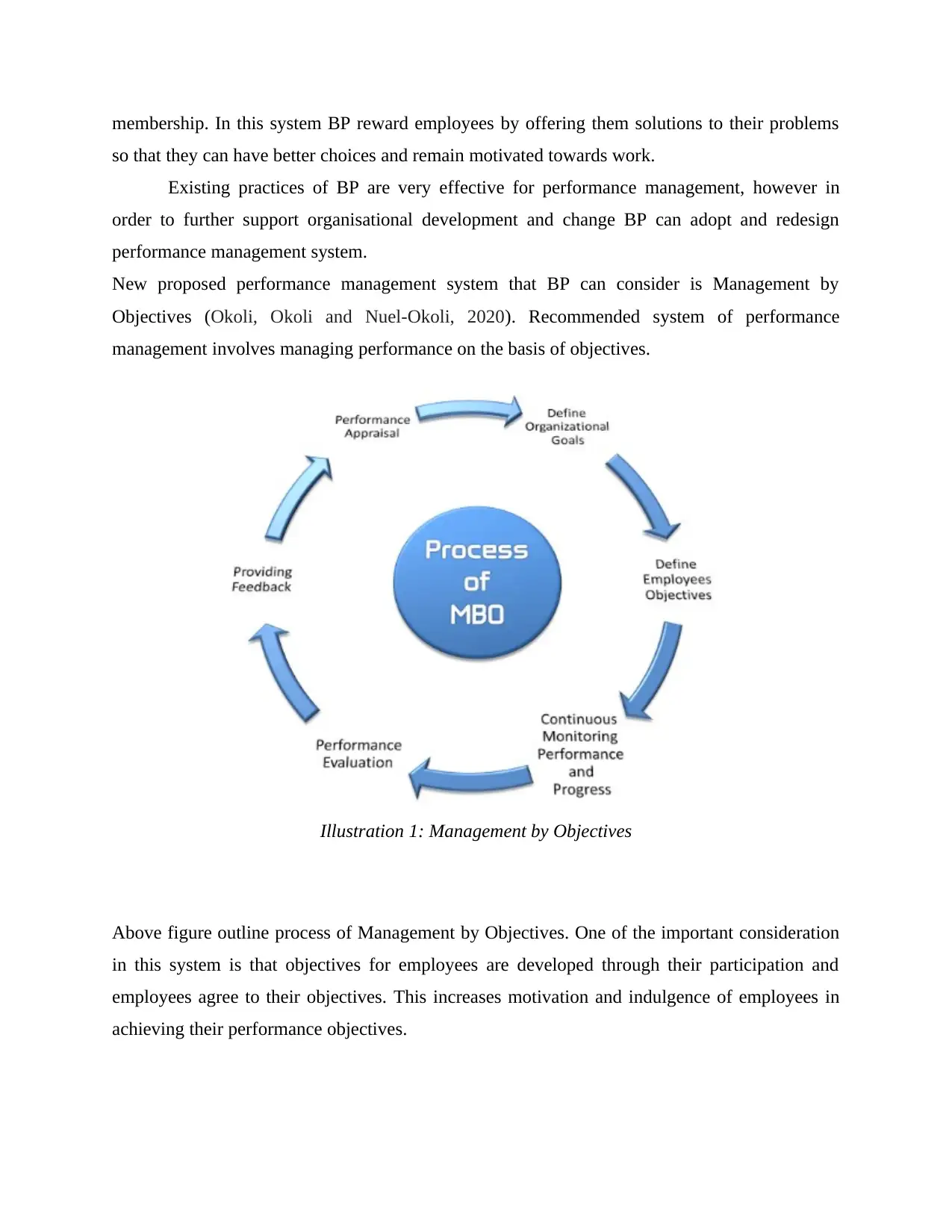
membership. In this system BP reward employees by offering them solutions to their problems
so that they can have better choices and remain motivated towards work.
Existing practices of BP are very effective for performance management, however in
order to further support organisational development and change BP can adopt and redesign
performance management system.
New proposed performance management system that BP can consider is Management by
Objectives (Okoli, Okoli and Nuel-Okoli, 2020). Recommended system of performance
management involves managing performance on the basis of objectives.
Above figure outline process of Management by Objectives. One of the important consideration
in this system is that objectives for employees are developed through their participation and
employees agree to their objectives. This increases motivation and indulgence of employees in
achieving their performance objectives.
Illustration 1: Management by Objectives
so that they can have better choices and remain motivated towards work.
Existing practices of BP are very effective for performance management, however in
order to further support organisational development and change BP can adopt and redesign
performance management system.
New proposed performance management system that BP can consider is Management by
Objectives (Okoli, Okoli and Nuel-Okoli, 2020). Recommended system of performance
management involves managing performance on the basis of objectives.
Above figure outline process of Management by Objectives. One of the important consideration
in this system is that objectives for employees are developed through their participation and
employees agree to their objectives. This increases motivation and indulgence of employees in
achieving their performance objectives.
Illustration 1: Management by Objectives
Paraphrase This Document
Need a fresh take? Get an instant paraphrase of this document with our AI Paraphraser
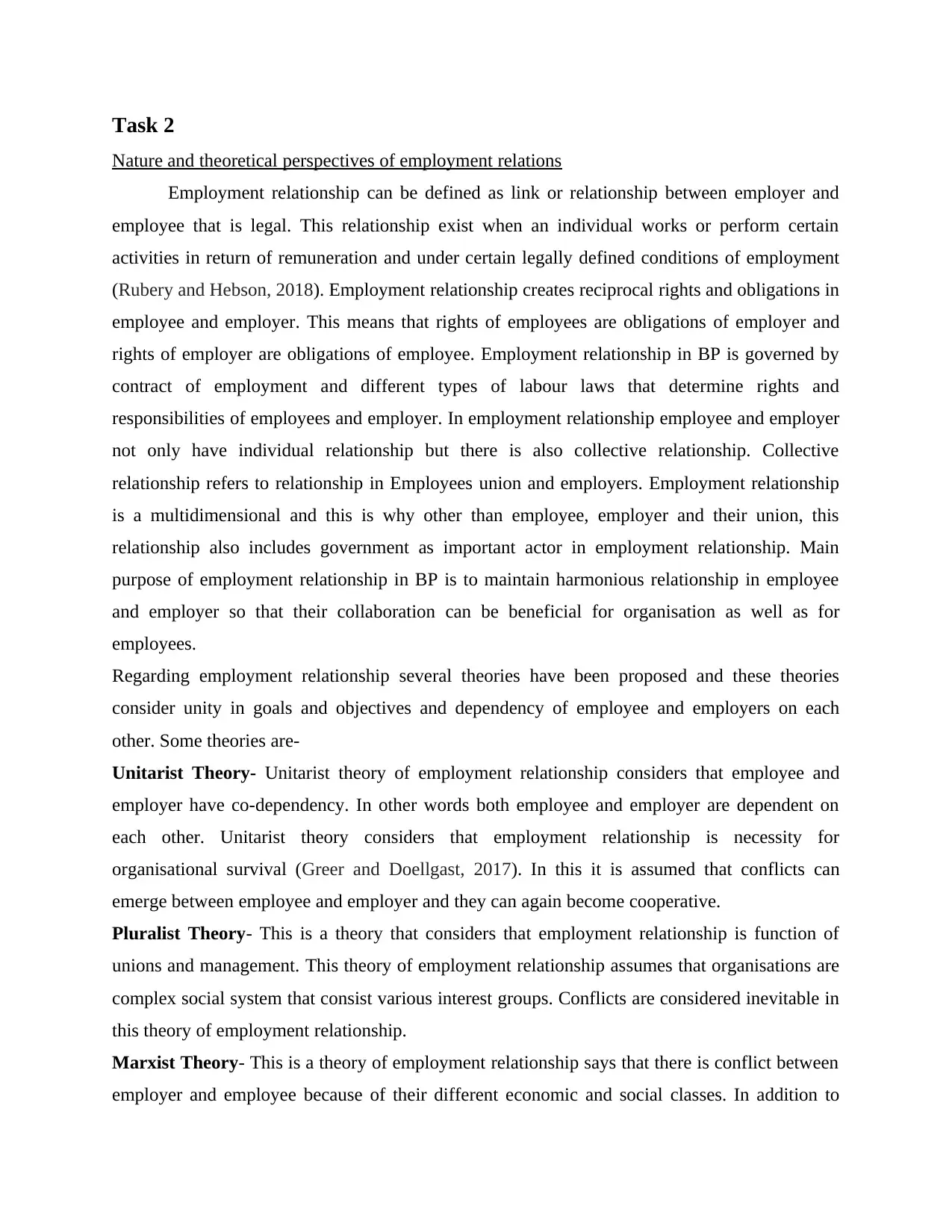
Task 2
Nature and theoretical perspectives of employment relations
Employment relationship can be defined as link or relationship between employer and
employee that is legal. This relationship exist when an individual works or perform certain
activities in return of remuneration and under certain legally defined conditions of employment
(Rubery and Hebson, 2018). Employment relationship creates reciprocal rights and obligations in
employee and employer. This means that rights of employees are obligations of employer and
rights of employer are obligations of employee. Employment relationship in BP is governed by
contract of employment and different types of labour laws that determine rights and
responsibilities of employees and employer. In employment relationship employee and employer
not only have individual relationship but there is also collective relationship. Collective
relationship refers to relationship in Employees union and employers. Employment relationship
is a multidimensional and this is why other than employee, employer and their union, this
relationship also includes government as important actor in employment relationship. Main
purpose of employment relationship in BP is to maintain harmonious relationship in employee
and employer so that their collaboration can be beneficial for organisation as well as for
employees.
Regarding employment relationship several theories have been proposed and these theories
consider unity in goals and objectives and dependency of employee and employers on each
other. Some theories are-
Unitarist Theory- Unitarist theory of employment relationship considers that employee and
employer have co-dependency. In other words both employee and employer are dependent on
each other. Unitarist theory considers that employment relationship is necessity for
organisational survival (Greer and Doellgast, 2017). In this it is assumed that conflicts can
emerge between employee and employer and they can again become cooperative.
Pluralist Theory- This is a theory that considers that employment relationship is function of
unions and management. This theory of employment relationship assumes that organisations are
complex social system that consist various interest groups. Conflicts are considered inevitable in
this theory of employment relationship.
Marxist Theory- This is a theory of employment relationship says that there is conflict between
employer and employee because of their different economic and social classes. In addition to
Nature and theoretical perspectives of employment relations
Employment relationship can be defined as link or relationship between employer and
employee that is legal. This relationship exist when an individual works or perform certain
activities in return of remuneration and under certain legally defined conditions of employment
(Rubery and Hebson, 2018). Employment relationship creates reciprocal rights and obligations in
employee and employer. This means that rights of employees are obligations of employer and
rights of employer are obligations of employee. Employment relationship in BP is governed by
contract of employment and different types of labour laws that determine rights and
responsibilities of employees and employer. In employment relationship employee and employer
not only have individual relationship but there is also collective relationship. Collective
relationship refers to relationship in Employees union and employers. Employment relationship
is a multidimensional and this is why other than employee, employer and their union, this
relationship also includes government as important actor in employment relationship. Main
purpose of employment relationship in BP is to maintain harmonious relationship in employee
and employer so that their collaboration can be beneficial for organisation as well as for
employees.
Regarding employment relationship several theories have been proposed and these theories
consider unity in goals and objectives and dependency of employee and employers on each
other. Some theories are-
Unitarist Theory- Unitarist theory of employment relationship considers that employee and
employer have co-dependency. In other words both employee and employer are dependent on
each other. Unitarist theory considers that employment relationship is necessity for
organisational survival (Greer and Doellgast, 2017). In this it is assumed that conflicts can
emerge between employee and employer and they can again become cooperative.
Pluralist Theory- This is a theory that considers that employment relationship is function of
unions and management. This theory of employment relationship assumes that organisations are
complex social system that consist various interest groups. Conflicts are considered inevitable in
this theory of employment relationship.
Marxist Theory- This is a theory of employment relationship says that there is conflict between
employer and employee because of their different economic and social classes. In addition to
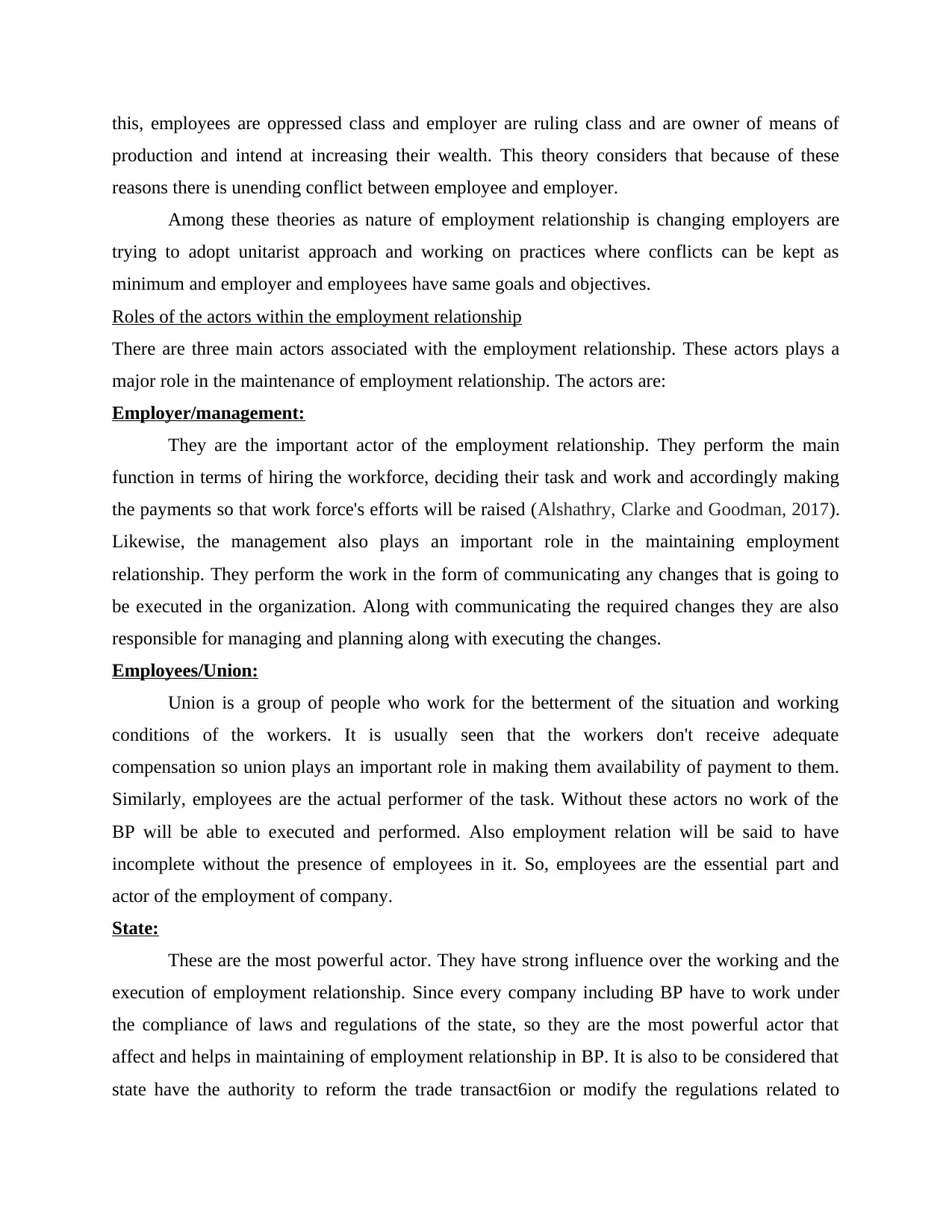
this, employees are oppressed class and employer are ruling class and are owner of means of
production and intend at increasing their wealth. This theory considers that because of these
reasons there is unending conflict between employee and employer.
Among these theories as nature of employment relationship is changing employers are
trying to adopt unitarist approach and working on practices where conflicts can be kept as
minimum and employer and employees have same goals and objectives.
Roles of the actors within the employment relationship
There are three main actors associated with the employment relationship. These actors plays a
major role in the maintenance of employment relationship. The actors are:
Employer/management:
They are the important actor of the employment relationship. They perform the main
function in terms of hiring the workforce, deciding their task and work and accordingly making
the payments so that work force's efforts will be raised (Alshathry, Clarke and Goodman, 2017).
Likewise, the management also plays an important role in the maintaining employment
relationship. They perform the work in the form of communicating any changes that is going to
be executed in the organization. Along with communicating the required changes they are also
responsible for managing and planning along with executing the changes.
Employees/Union:
Union is a group of people who work for the betterment of the situation and working
conditions of the workers. It is usually seen that the workers don't receive adequate
compensation so union plays an important role in making them availability of payment to them.
Similarly, employees are the actual performer of the task. Without these actors no work of the
BP will be able to executed and performed. Also employment relation will be said to have
incomplete without the presence of employees in it. So, employees are the essential part and
actor of the employment of company.
State:
These are the most powerful actor. They have strong influence over the working and the
execution of employment relationship. Since every company including BP have to work under
the compliance of laws and regulations of the state, so they are the most powerful actor that
affect and helps in maintaining of employment relationship in BP. It is also to be considered that
state have the authority to reform the trade transact6ion or modify the regulations related to
production and intend at increasing their wealth. This theory considers that because of these
reasons there is unending conflict between employee and employer.
Among these theories as nature of employment relationship is changing employers are
trying to adopt unitarist approach and working on practices where conflicts can be kept as
minimum and employer and employees have same goals and objectives.
Roles of the actors within the employment relationship
There are three main actors associated with the employment relationship. These actors plays a
major role in the maintenance of employment relationship. The actors are:
Employer/management:
They are the important actor of the employment relationship. They perform the main
function in terms of hiring the workforce, deciding their task and work and accordingly making
the payments so that work force's efforts will be raised (Alshathry, Clarke and Goodman, 2017).
Likewise, the management also plays an important role in the maintaining employment
relationship. They perform the work in the form of communicating any changes that is going to
be executed in the organization. Along with communicating the required changes they are also
responsible for managing and planning along with executing the changes.
Employees/Union:
Union is a group of people who work for the betterment of the situation and working
conditions of the workers. It is usually seen that the workers don't receive adequate
compensation so union plays an important role in making them availability of payment to them.
Similarly, employees are the actual performer of the task. Without these actors no work of the
BP will be able to executed and performed. Also employment relation will be said to have
incomplete without the presence of employees in it. So, employees are the essential part and
actor of the employment of company.
State:
These are the most powerful actor. They have strong influence over the working and the
execution of employment relationship. Since every company including BP have to work under
the compliance of laws and regulations of the state, so they are the most powerful actor that
affect and helps in maintaining of employment relationship in BP. It is also to be considered that
state have the authority to reform the trade transact6ion or modify the regulations related to
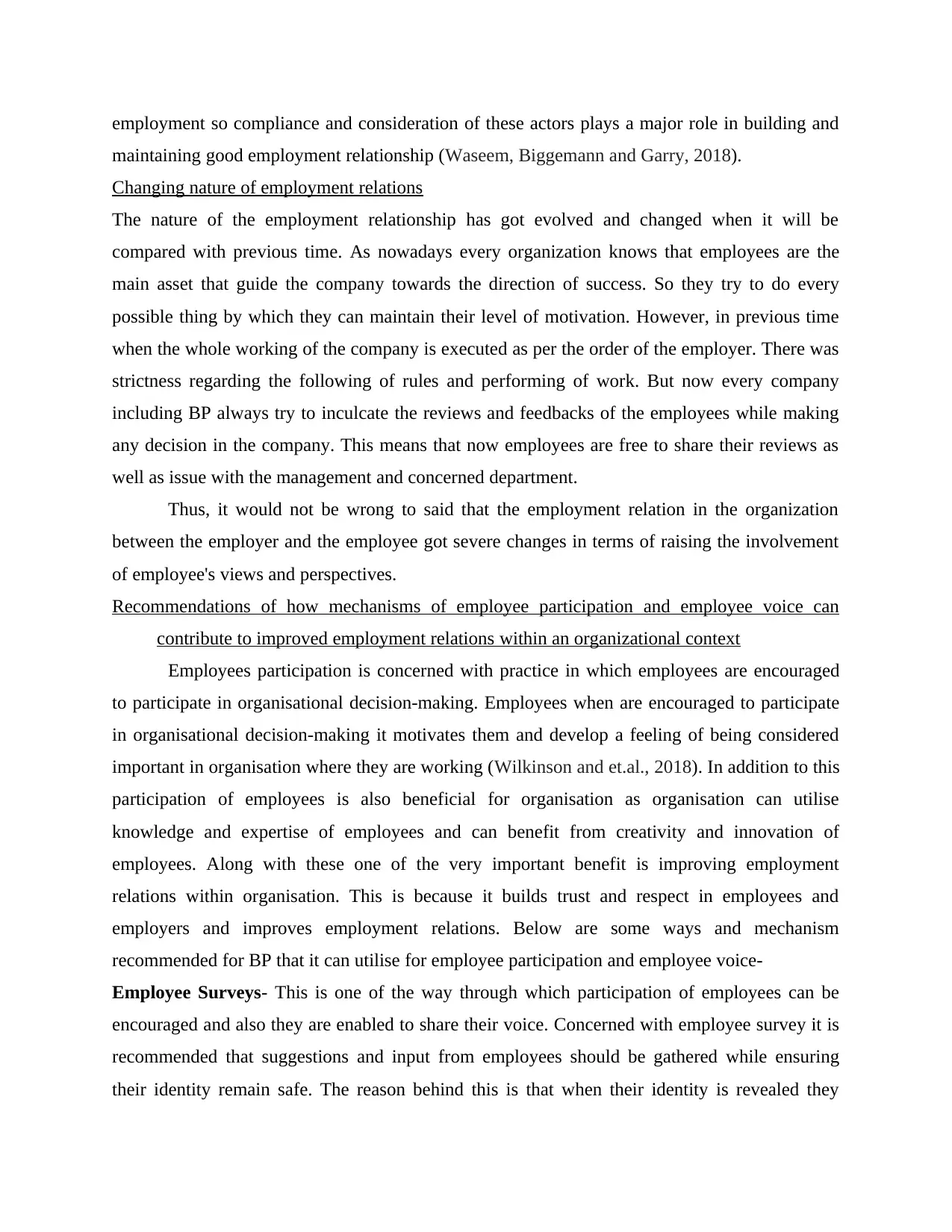
employment so compliance and consideration of these actors plays a major role in building and
maintaining good employment relationship (Waseem, Biggemann and Garry, 2018).
Changing nature of employment relations
The nature of the employment relationship has got evolved and changed when it will be
compared with previous time. As nowadays every organization knows that employees are the
main asset that guide the company towards the direction of success. So they try to do every
possible thing by which they can maintain their level of motivation. However, in previous time
when the whole working of the company is executed as per the order of the employer. There was
strictness regarding the following of rules and performing of work. But now every company
including BP always try to inculcate the reviews and feedbacks of the employees while making
any decision in the company. This means that now employees are free to share their reviews as
well as issue with the management and concerned department.
Thus, it would not be wrong to said that the employment relation in the organization
between the employer and the employee got severe changes in terms of raising the involvement
of employee's views and perspectives.
Recommendations of how mechanisms of employee participation and employee voice can
contribute to improved employment relations within an organizational context
Employees participation is concerned with practice in which employees are encouraged
to participate in organisational decision-making. Employees when are encouraged to participate
in organisational decision-making it motivates them and develop a feeling of being considered
important in organisation where they are working (Wilkinson and et.al., 2018). In addition to this
participation of employees is also beneficial for organisation as organisation can utilise
knowledge and expertise of employees and can benefit from creativity and innovation of
employees. Along with these one of the very important benefit is improving employment
relations within organisation. This is because it builds trust and respect in employees and
employers and improves employment relations. Below are some ways and mechanism
recommended for BP that it can utilise for employee participation and employee voice-
Employee Surveys- This is one of the way through which participation of employees can be
encouraged and also they are enabled to share their voice. Concerned with employee survey it is
recommended that suggestions and input from employees should be gathered while ensuring
their identity remain safe. The reason behind this is that when their identity is revealed they
maintaining good employment relationship (Waseem, Biggemann and Garry, 2018).
Changing nature of employment relations
The nature of the employment relationship has got evolved and changed when it will be
compared with previous time. As nowadays every organization knows that employees are the
main asset that guide the company towards the direction of success. So they try to do every
possible thing by which they can maintain their level of motivation. However, in previous time
when the whole working of the company is executed as per the order of the employer. There was
strictness regarding the following of rules and performing of work. But now every company
including BP always try to inculcate the reviews and feedbacks of the employees while making
any decision in the company. This means that now employees are free to share their reviews as
well as issue with the management and concerned department.
Thus, it would not be wrong to said that the employment relation in the organization
between the employer and the employee got severe changes in terms of raising the involvement
of employee's views and perspectives.
Recommendations of how mechanisms of employee participation and employee voice can
contribute to improved employment relations within an organizational context
Employees participation is concerned with practice in which employees are encouraged
to participate in organisational decision-making. Employees when are encouraged to participate
in organisational decision-making it motivates them and develop a feeling of being considered
important in organisation where they are working (Wilkinson and et.al., 2018). In addition to this
participation of employees is also beneficial for organisation as organisation can utilise
knowledge and expertise of employees and can benefit from creativity and innovation of
employees. Along with these one of the very important benefit is improving employment
relations within organisation. This is because it builds trust and respect in employees and
employers and improves employment relations. Below are some ways and mechanism
recommended for BP that it can utilise for employee participation and employee voice-
Employee Surveys- This is one of the way through which participation of employees can be
encouraged and also they are enabled to share their voice. Concerned with employee survey it is
recommended that suggestions and input from employees should be gathered while ensuring
their identity remain safe. The reason behind this is that when their identity is revealed they
Secure Best Marks with AI Grader
Need help grading? Try our AI Grader for instant feedback on your assignments.
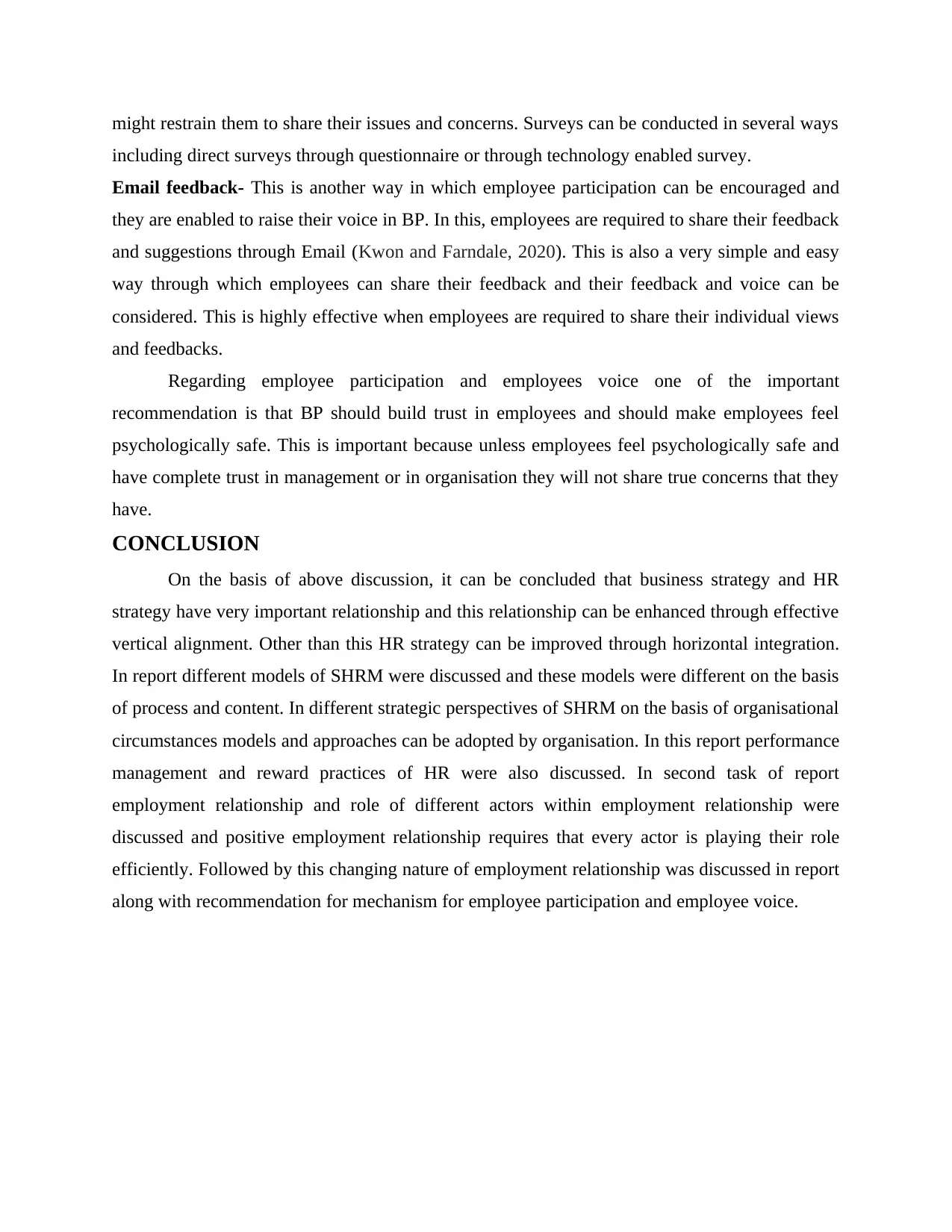
might restrain them to share their issues and concerns. Surveys can be conducted in several ways
including direct surveys through questionnaire or through technology enabled survey.
Email feedback- This is another way in which employee participation can be encouraged and
they are enabled to raise their voice in BP. In this, employees are required to share their feedback
and suggestions through Email (Kwon and Farndale, 2020). This is also a very simple and easy
way through which employees can share their feedback and their feedback and voice can be
considered. This is highly effective when employees are required to share their individual views
and feedbacks.
Regarding employee participation and employees voice one of the important
recommendation is that BP should build trust in employees and should make employees feel
psychologically safe. This is important because unless employees feel psychologically safe and
have complete trust in management or in organisation they will not share true concerns that they
have.
CONCLUSION
On the basis of above discussion, it can be concluded that business strategy and HR
strategy have very important relationship and this relationship can be enhanced through effective
vertical alignment. Other than this HR strategy can be improved through horizontal integration.
In report different models of SHRM were discussed and these models were different on the basis
of process and content. In different strategic perspectives of SHRM on the basis of organisational
circumstances models and approaches can be adopted by organisation. In this report performance
management and reward practices of HR were also discussed. In second task of report
employment relationship and role of different actors within employment relationship were
discussed and positive employment relationship requires that every actor is playing their role
efficiently. Followed by this changing nature of employment relationship was discussed in report
along with recommendation for mechanism for employee participation and employee voice.
including direct surveys through questionnaire or through technology enabled survey.
Email feedback- This is another way in which employee participation can be encouraged and
they are enabled to raise their voice in BP. In this, employees are required to share their feedback
and suggestions through Email (Kwon and Farndale, 2020). This is also a very simple and easy
way through which employees can share their feedback and their feedback and voice can be
considered. This is highly effective when employees are required to share their individual views
and feedbacks.
Regarding employee participation and employees voice one of the important
recommendation is that BP should build trust in employees and should make employees feel
psychologically safe. This is important because unless employees feel psychologically safe and
have complete trust in management or in organisation they will not share true concerns that they
have.
CONCLUSION
On the basis of above discussion, it can be concluded that business strategy and HR
strategy have very important relationship and this relationship can be enhanced through effective
vertical alignment. Other than this HR strategy can be improved through horizontal integration.
In report different models of SHRM were discussed and these models were different on the basis
of process and content. In different strategic perspectives of SHRM on the basis of organisational
circumstances models and approaches can be adopted by organisation. In this report performance
management and reward practices of HR were also discussed. In second task of report
employment relationship and role of different actors within employment relationship were
discussed and positive employment relationship requires that every actor is playing their role
efficiently. Followed by this changing nature of employment relationship was discussed in report
along with recommendation for mechanism for employee participation and employee voice.
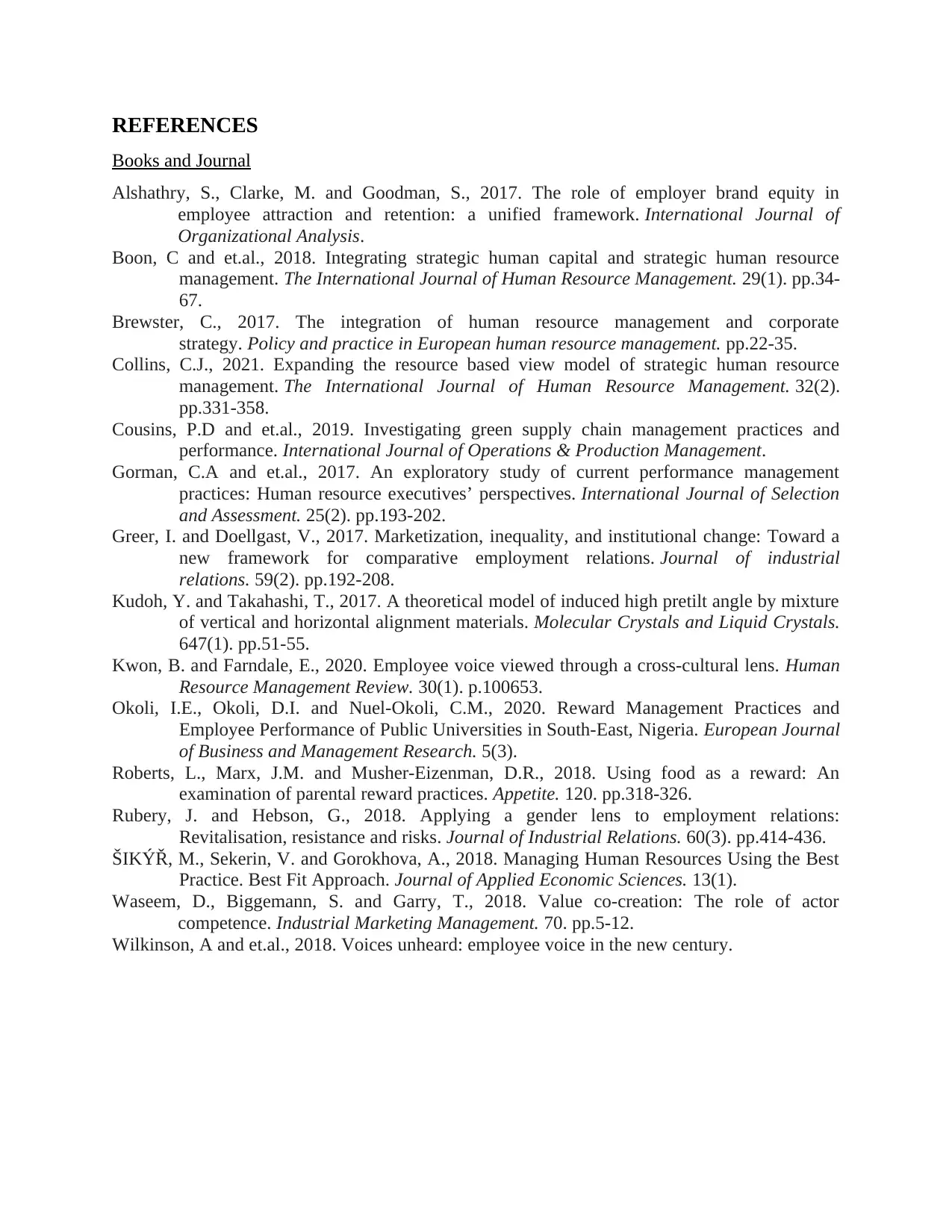
REFERENCES
Books and Journal
Alshathry, S., Clarke, M. and Goodman, S., 2017. The role of employer brand equity in
employee attraction and retention: a unified framework. International Journal of
Organizational Analysis.
Boon, C and et.al., 2018. Integrating strategic human capital and strategic human resource
management. The International Journal of Human Resource Management. 29(1). pp.34-
67.
Brewster, C., 2017. The integration of human resource management and corporate
strategy. Policy and practice in European human resource management. pp.22-35.
Collins, C.J., 2021. Expanding the resource based view model of strategic human resource
management. The International Journal of Human Resource Management. 32(2).
pp.331-358.
Cousins, P.D and et.al., 2019. Investigating green supply chain management practices and
performance. International Journal of Operations & Production Management.
Gorman, C.A and et.al., 2017. An exploratory study of current performance management
practices: Human resource executives’ perspectives. International Journal of Selection
and Assessment. 25(2). pp.193-202.
Greer, I. and Doellgast, V., 2017. Marketization, inequality, and institutional change: Toward a
new framework for comparative employment relations. Journal of industrial
relations. 59(2). pp.192-208.
Kudoh, Y. and Takahashi, T., 2017. A theoretical model of induced high pretilt angle by mixture
of vertical and horizontal alignment materials. Molecular Crystals and Liquid Crystals.
647(1). pp.51-55.
Kwon, B. and Farndale, E., 2020. Employee voice viewed through a cross-cultural lens. Human
Resource Management Review. 30(1). p.100653.
Okoli, I.E., Okoli, D.I. and Nuel-Okoli, C.M., 2020. Reward Management Practices and
Employee Performance of Public Universities in South-East, Nigeria. European Journal
of Business and Management Research. 5(3).
Roberts, L., Marx, J.M. and Musher-Eizenman, D.R., 2018. Using food as a reward: An
examination of parental reward practices. Appetite. 120. pp.318-326.
Rubery, J. and Hebson, G., 2018. Applying a gender lens to employment relations:
Revitalisation, resistance and risks. Journal of Industrial Relations. 60(3). pp.414-436.
ŠIKÝŘ, M., Sekerin, V. and Gorokhova, A., 2018. Managing Human Resources Using the Best
Practice. Best Fit Approach. Journal of Applied Economic Sciences. 13(1).
Waseem, D., Biggemann, S. and Garry, T., 2018. Value co-creation: The role of actor
competence. Industrial Marketing Management. 70. pp.5-12.
Wilkinson, A and et.al., 2018. Voices unheard: employee voice in the new century.
Books and Journal
Alshathry, S., Clarke, M. and Goodman, S., 2017. The role of employer brand equity in
employee attraction and retention: a unified framework. International Journal of
Organizational Analysis.
Boon, C and et.al., 2018. Integrating strategic human capital and strategic human resource
management. The International Journal of Human Resource Management. 29(1). pp.34-
67.
Brewster, C., 2017. The integration of human resource management and corporate
strategy. Policy and practice in European human resource management. pp.22-35.
Collins, C.J., 2021. Expanding the resource based view model of strategic human resource
management. The International Journal of Human Resource Management. 32(2).
pp.331-358.
Cousins, P.D and et.al., 2019. Investigating green supply chain management practices and
performance. International Journal of Operations & Production Management.
Gorman, C.A and et.al., 2017. An exploratory study of current performance management
practices: Human resource executives’ perspectives. International Journal of Selection
and Assessment. 25(2). pp.193-202.
Greer, I. and Doellgast, V., 2017. Marketization, inequality, and institutional change: Toward a
new framework for comparative employment relations. Journal of industrial
relations. 59(2). pp.192-208.
Kudoh, Y. and Takahashi, T., 2017. A theoretical model of induced high pretilt angle by mixture
of vertical and horizontal alignment materials. Molecular Crystals and Liquid Crystals.
647(1). pp.51-55.
Kwon, B. and Farndale, E., 2020. Employee voice viewed through a cross-cultural lens. Human
Resource Management Review. 30(1). p.100653.
Okoli, I.E., Okoli, D.I. and Nuel-Okoli, C.M., 2020. Reward Management Practices and
Employee Performance of Public Universities in South-East, Nigeria. European Journal
of Business and Management Research. 5(3).
Roberts, L., Marx, J.M. and Musher-Eizenman, D.R., 2018. Using food as a reward: An
examination of parental reward practices. Appetite. 120. pp.318-326.
Rubery, J. and Hebson, G., 2018. Applying a gender lens to employment relations:
Revitalisation, resistance and risks. Journal of Industrial Relations. 60(3). pp.414-436.
ŠIKÝŘ, M., Sekerin, V. and Gorokhova, A., 2018. Managing Human Resources Using the Best
Practice. Best Fit Approach. Journal of Applied Economic Sciences. 13(1).
Waseem, D., Biggemann, S. and Garry, T., 2018. Value co-creation: The role of actor
competence. Industrial Marketing Management. 70. pp.5-12.
Wilkinson, A and et.al., 2018. Voices unheard: employee voice in the new century.
1 out of 12
Related Documents
Your All-in-One AI-Powered Toolkit for Academic Success.
+13062052269
info@desklib.com
Available 24*7 on WhatsApp / Email
![[object Object]](/_next/static/media/star-bottom.7253800d.svg)
Unlock your academic potential
© 2024 | Zucol Services PVT LTD | All rights reserved.





